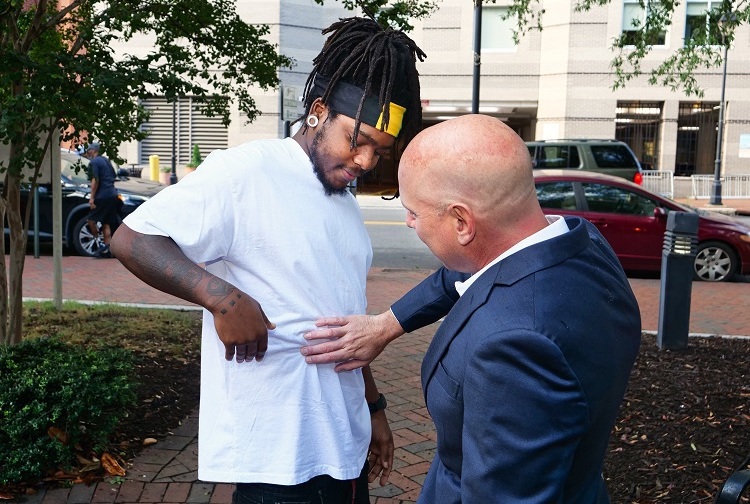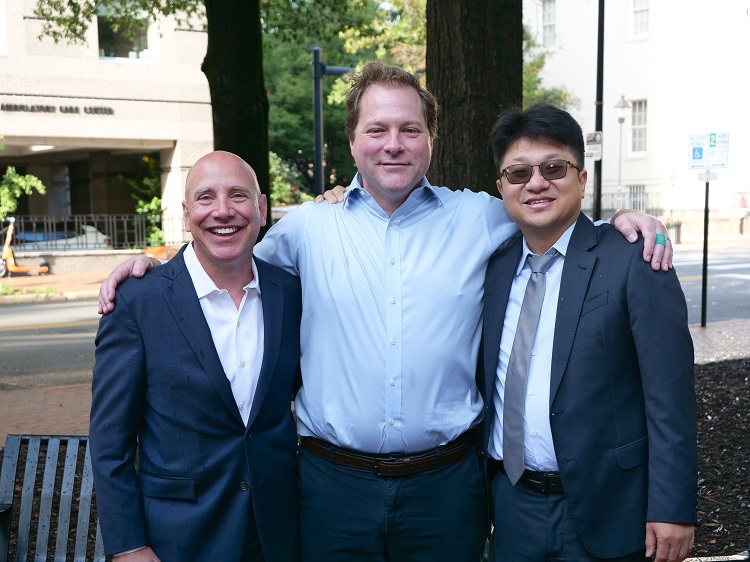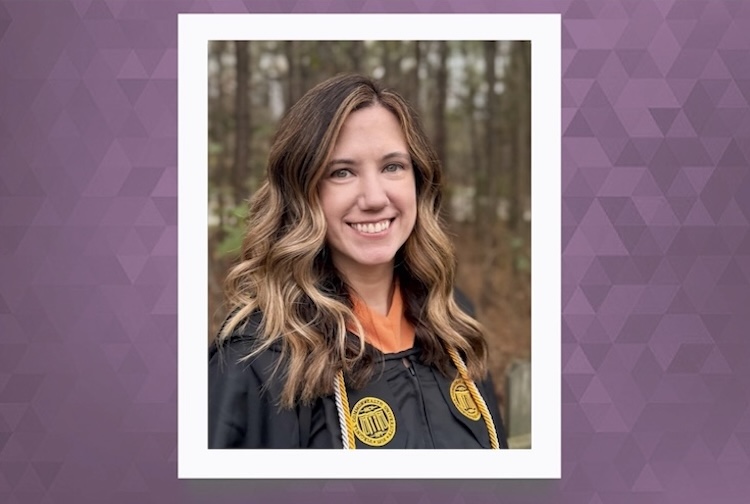At the 'extreme edge' of transplant possibility, VCU Health says 'Yes' to liver cancer patient
Patient's fiancée becomes one of first living donors to undergo fully robotic surgery at VCU Health Hume-Lee Transplant Center.
October 16, 2023 Jessica Garrett donated part of her liver to then-boyfriend Shannon “Christ” Harris. The couple are now engaged and are all smiles after fully recovering from their surgeries at VCU Health Hume-Lee Transplant Center. (VCU Enterprise Marketing and Communications)
Jessica Garrett donated part of her liver to then-boyfriend Shannon “Christ” Harris. The couple are now engaged and are all smiles after fully recovering from their surgeries at VCU Health Hume-Lee Transplant Center. (VCU Enterprise Marketing and Communications)
By Jeff Kelley
Shannon “Christ” (pronounced Chris) Harris' abdominal pain reached the point where he couldn't bend down to put on shoes. He and his fiancée, Jessica Garrett, thought it was a good idea to get checked out at a nearby Atlanta ER.
Once there, he was admitted over that November 2022 night, and scans the next day revealed a likely diagnosis of hepatocellular carcinoma (HCC), the most common form of liver cancer.
“They said, 'You can't leave this floor,'” Harris said. He remained in the hospital and a week later, surgeons removed 75% of his liver in a procedure called a resection, with the hope being the cancer was removed with the organ. The liver grows back within a few weeks.
While pathology confirmed the HCC diagnosis, the couple figured the worst was behind them. But a follow-up scan in March showed the cancer had returned.
“They told me the only way out was a liver transplant,” Harris said. “They immediately referred us to VCU Health.”
Harris' diagnosis was later upgraded to fibrolamellar HCC, an ultra-rare form primarily occurring in young adults. Though transplantation is a method of treatment, due to a national waiting list of over 10,000 patients, a scoring system putting the sickest candidates at the top of the list and the fact he'd already undergone a resection — Harris would die waiting.

Shannon “Christ” Harris, liver recipient, and David Bruno, M.D., “examining” the transplant scar. (VCU Enterprise Marketing and Communications)
Unending hope to find a solution
For Harris, a musician and abstract artist, the only viable transplant option was to find a living donor. Lucky for him, he didn't have to go far to find one.
“The second they said he could get a living donor, I wanted to go get tested,” Garrett said.
A week after learning the cancer had returned, the couple made the 8-hour drive from Atlanta to VCU Health Hume-Lee Transplant Center in Richmond, where Garrett — despite having an incompatible blood type — was ruled a healthy living donor candidate for a partner she's known for a decade.
“The fact that she wanted to do the surgery is really the starting criteria for finding a liver donor,” said Joel Wedd, M.D., Hume-Lee's medical director of liver transplant. “The matching process for livers is much less rigorous from a biochemical perspective than it is in other organs [such as kidneys], because the liver is a relatively immune-tolerant organ when transplanted. It still has risk of rejection, but it's not as high.”
While the donor was lined up, the question of who would pay for the complicated surgery was not.
“This was a difficult, apex-level transplant case. We just don't see cases like Christ. His surgery was so on the extreme edge of what we do — you typically don't transplant people who have had a resection, or recurrence after a resection,” said David Bruno, M.D., interim chair and surgical director of liver transplant at Hume-Lee. “But from the moment I met him, I knew I was going to figure out a way to get this transplant done.”
For almost two months, the couple and Hume-Lee team went back and forth with Harris' insurance to make the case for covering the transplant. At this point, he was planning to move forward with radiofrequency ablation, a minimally invasive procedure that shrinks the size of tumors or other growths in the body, when Bruno received news that changed the trajectory of Harris' treatment plan.
Bruno's phone rang on a Friday afternoon when he was at a farm-supply store buying grease for his tractor. It was the medical director from the insurance company. With patient privacy in mind, he popped into an empty office at the store to take the call.
“I was anxious, because we had gotten some denials. But I talked to the medical director, and he said he was approving it,” said Bruno, his eyes welling up. “I remember getting really emotional about it. Being able to help someone like that is the greatest.”

Shannon “Christ” Harris is an abstract artist. This artwork, entitled GRAF, is the only painting Harris says he has completed since being diagnosed earlier this year.. (Contributed by Shannon “Christ” Harris)
A “roundabout path” leads to a supportive road to recovery
Since the June transplant, Harris and Garrett have remained in central Virginia, renting an apartment in Old Towne Petersburg. He typically has follow-up appointments in Richmond on Thursdays.
Garrett was the fifth patient at VCU Health to have her liver removed entirely by robot, which Seung Duk Lee, M.D., associate surgical director of liver transplant, only began performing in April. Hume-Lee is the only center on the East Coast actively offering full robotic hepatectomies, after becoming the third U.S. center to successfully perform the procedure. Her scar is similar to that of a C-section, with four tiny punctures on her abdomen, from where the robotic arms are inserted. With the robot, healing is faster, the pain minimized, the scarring less.
“I think the surgeons were just excited to get to do a robotic surgery,” Garrett joked.
For the recipient, the procedure is still a traditional open transplant with “the Mercedes-Benz” scar. Today, Harris is considered cancer-free. He'll be scanned every three months for the foreseeable future.
“It's kind of ridiculous how fast VCU Health got everything done. I don't think there's anywhere else in the world where we could have gotten that turnaround. Three months for a liver transplant is unheard of,” Harris said.
From the beginning of the process to seeing Harris in recovery, Bruno says the transplant program's efforts to care for this patient truly embodies the character and ideals of Hume-Lee.
“In that, we're going to figure out how to say 'Yes,'” Bruno said. “It may be a little bit of a roundabout path, but we're going to get someone where they need to go.”

From left to right: David Bruno, M.D., FACS, who was Shannon “Christ” Harris' surgeon; Joel Wedd, M.D., MPH, medical director who initially saw the patient; and Seung Duk Lee, M.D., Ph.D. who performed the living liver robotics surgery for Jessica Garrett. (VCU Enterprise Marketing and Communications)




.jpg)